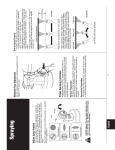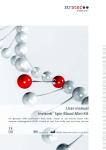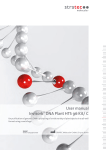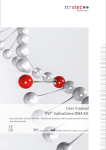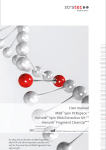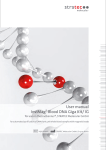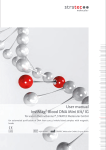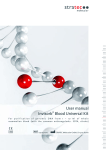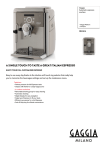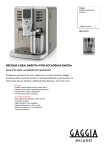Download Invisorb DNA CleanUp User manual
Transcript
User manual Invisorb® DNA CleanUp for purification of DNA fragments after PCR reactions & purification of contaminated DNA after DNA isolation REF 1020400x0 STRATEC Molecular GmbH, D-13125 Berlin Instruction for Invisorb® DNA CleanUp The Invisorb® DNA CleanUp provides a convenient tool for fast and efficient direct purification of contaminated DNA after DNA isolation as well as for fast and efficient direct purification of PCR* products from 80 bp up to 30 kb from amplification reactions. ® Trademarks: Invisorb , Registered marks, trademarks, etc. used in this document, even when not specifically marked as such, are not to be considered unprotected by law. ® The Invisorb technology is covered by patents and patent applications: US 6,110363, US 6,043,354, US 6,037,465, EP 0880535, WO 9728171, WO 9534569, EP 0765335, DE 19506887, DE 10041825.2, WO 0034463. ® Invisorb is a registered trademark of STRATEC Biomedical AG. The PCR process is covered by US Patents 4,683,195, and 4,683,202 and foreign equivalents owned by Hoffmann-La Roche AG. © 2015 STRATEC Molecular, all rights reserved. 1 ® Invisorb DNA CleanUp 0515 Contents Kit contents of Invisorb® DNA CleanUp 3 Symbols 4 Storage 4 Quality control 4 Intended use 5 Product use limitation 5 Safety information 5 Product characteristic of Invisorb® DNA CleanUp 6 Principle and procedure 7 Important notes 7 Important points before starting a protocol 7 Preparing reagents and buffers 8 Reagents and equipment to be supplied by user 8 Scheme 9 Instructions 10 Protocol 1: Purification of contaminated DNA after DNA isolation from up to 50 µl 10 Protocol 2: Purification of contaminated DNA after DNA isolation up to 50 - 200 µl 11 Protocol 3: Purification of PCR-products from PCR reaction mixes up to 50 µl 12 Protocol 4: Purification of PCR-products from PCR reaction mixes up to 50 - 200µl 13 Troubleshooting 14 Appendix 14 General notes on handling DNA 14 Ordering information 14 2 ® Invisorb DNA CleanUp 0515 Kit contents of Invisorb® DNA CleanUp Store all kit components at room temperature! 50 purifications 250 purifications 1020400100 1020400200 1020400300 2 x 1 ml 10 ml (final volume 20 ml) 40 ml (final volume 80 ml) Wash Buffer 5 ml (ready to use) 24 ml (final volume 60 ml) 80 ml (final volume 200 ml) Wash Buffer I 15 ml (ready to use) 30 ml (final volume 60 ml) 80 ml (final volume 160 ml) Wash Buffer II 15 ml (ready to use) 18 ml (final volume 60 ml) 60 ml (final volume 200 ml) Elution Buffer 2 ml 15 ml 30 ml Spin Filter 5 50 5 x 50 2.0 ml Receiver Tubes 5 50 5 x 50 1.5 ml Receiver Tubes 5 50 5 x 50 Manual 1 1 1 add 10 ml 99,7% Isopropanol to the Buffer P. Mix by intensive shaking by inverting for 1 min. Shortly before use mix by inverting several times add 40 ml 99,7% Isopropanol to the Buffer P. Mix by intensive shaking by inverting for 1 min. Shortly before use mix by inverting several times add 36 ml 96-100% ethanol to the bottle Wash Buffer add 120 ml 96-100% ethanol to each bottle Wash Buffer add 30 ml 96-100% ethanol to the bottle Wash Buffer I add 80 ml 96-100% ethanol to the bottle Wash Buffer I add 42 ml 96-100% ethanol to the bottle Wash Buffer II add 140 ml 96-100% ethanol to the bottle Wash Buffer II 5 purifications Catalog No. Buffer P Initial steps 3 ® Invisorb DNA CleanUp 0515 Symbols Manufacturer Lot number Catalogue number Expiry date Consult operating instructions Temperature limitation Do not reuse Storage The Invisorb® DNA CleanUp should be stored dry, at room temperature and is stable for at least 12 months under these conditions. Make sure that all components have room temperature. If there should be any precipitates in the reagents provided, dissolve them by careful warming up to 37°C. Room temperature (RT) is defined as range from 15 - 30°C. Quality control and product warranty STRATEC Molecular warrants the correct function of the Invisorb® DNA CleanUp for applications as described in this manual. Purchaser must determine the suitability of the Product for its particular use. Should any Product fail to perform the applications as described in the manual, STRATEC Molecular will check the lot and if STRATEC Molecular investigates a problem in the lot, STRATEC Molecular will replace the Product free of charge. STRATEC Molecular reserves the right to change, alter, or modify any Product to enhance its performance and design at any time. In accordance with STRATEC Molecular’s ISO 9001-2000 and ISO EN 13485 certified Quality Management System the performance of all components of the Invisorb® DNA CleanUp have been tested separately against predetermined specifications routinely on lot-to-lot to ensure consistent product quality. If you have any questions or problems regarding any aspects of Invisorb® DNA CleanUp or other STRATEC Molecular products, please do not hesitate to contact us. A copy of STRATEC Molecular’s terms and conditions can be obtained upon request or are presented at the STRATEC Molecular webpage. For technical support or further information please contact: from Germany +49-(0)30-9489-2901/ 2910 from abroad +49-(0)30-9489-2907 or contact your local distributor. 4 ® Invisorb DNA CleanUp 0515 Intended use The Invisorb® DNA CleanUp provides a convenient tool for fast and efficient cleanup of strong contaminated DNA, DNA fragments and PCR products, DNA isolated using classical procedures and DNA from reaction mixtures like the bisulfite method used in methylation analysis. DNA purified by the Invisorb® DNA CleanUp is ready to use for a broad panel of downstream applications. THE PRODUCT IS INTENDED FOR USE BY PROFESSIONALS ONLY, SUCH AS TECHNICIANS, PHYSICIANS AND BIOLOGISTS TRAINED IN MOLECULAR BIOLOGICAL TECHNIQUES. It is designed to be used with any downstream application employing enzymatic amplification or other enzymatic modifications of DNA followed by signal detection or amplification. Any diagnostic results generated by using the sample preparation procedure in conjunction with any downstream diagnostic assay should be interpreted with regard to other clinical or laboratory findings. To minimize irregularities in diagnostic results, adequate controls for downstream applications should be used. Product use limitation The Kit is neither for isolation and purification of pDNA, nor for isolation and purification of RNA. The included chemicals are only useable once. Differing of starting material or flow trace may lead to inoperability; therefore neither a warranty nor guarantee in this case will be given, neither implied nor express. The user is responsible to validate the performance of the STRATEC Molecular Product for any particular use. STRATEC Molecular does not provide for validation of performance characteristics of the Product with respect to specific applications. STRATEC Molecular Products may be used e.g.in clinical diagnostic laboratory systems conditioned upon the complete diagnostic system of the laboratory the laboratory has been validated pursuant to CLIA’ 88 regulations in the U.S. or equivalents in other countries. All Products sold by STRATEC Molecular are subject to extensive quality control procedures (according to ISO 9001-2000 and ISO EN 13485) and are warranted to perform as described herein. Any problems, incidents or defects shall be reported to STRATEC Molecular immediately upon detection thereof. The chemicals and the plastic parts are for laboratory use only; they must be stored in the laboratory and must not be used for purposes other than intended. The Product with its contents is unfit for consumption. Safety information When and while working with chemicals, always wear a suitable lab coat, disposable gloves, and protective goggles! Avoid skin contact! Adhere to the legal requirements for working with biological material! For more information, please consult the appropriate material safety data sheets (MSDS). These are available online in convenient and compact PDF format at www.stratec.com for each STRATEC Molecular Product and its components. If buffer bottles are damaged or leaking, WEAR GLOVES, AND PROTECTIVE GOGGLES when discarding the bottles in order to avoid any injuries. European Community risk and safety phrases for the components of the Invisorb® DNA CleanUp to which they apply are listed below as follows: 5 ® Invisorb DNA CleanUp 0515 H302: H312: H332: H412: EUH032: Wash Buffer I warning H 302-312-332-412 EUH032 P273 Harmful if swallowed. Harmful in contact with skin. Harmful if inhaled. Harmful to aquatic life with long lasting effects. Contact with acids liberates very toxic gas. present and easy to do. Continue rinsing. Avoid release to the environment. P273: Emergency medical information can be obtained 24 hours a day from infotrac: outside of USA: in USA : 1 – 352 – 323 – 3500 1 – 800 – 535 – 5053 Product characteristic of Invisorb® DNA CleanUp Starting material Rate of recovery Time for preparation up to 200 µl of DNA eluate up to 100 µl of amplification reaction volume up to 100 µl of reaction mixtures 60 % - 85 % depends on fragment length less than 10 minutes The Invisorb® DNA CleanUp provides a convenient tool for fast and efficient cleanup of strong contaminated DNA, DNA fragments and PCR products (80 bp up to 30 kb), DNA isolated using classical procedures and DNA from reaction mixtures like the bisulfite method used in methylation analysis. The optimized Binding Buffer adjust the condition and DNA or DNA-fragments will be bound directly onto the surface of a spin filter column during contaminats will be passed through during washing step(s). The buffer volumes are balanced to minimize pipetting steps. The Buffer P is added directly to the sample, adjusting the binding condition for DNA or DNA-fragments and the mixture is applied to the spin filter column. The DNA fragments are bound directly onto the membrane of a spin filter column. After washing to remove contaminants the DNA or DNA fragments are eluted in a low-salt buffer or ddH2O. The purification protocol as well as all buffers are optimized to provide high yield and purity of the recovered DNA fragment. The “hands-on time“ necessary for the whole procedure is reduced to a minimum. The purified DNA fragments are ready to use in various downstream application such as: ○ ○ ○ ○ ○ ○ Digestion with restriction enzymes Hybridization Labeling Cloning Sequencing In vitro Transcription The PCR method is covered by U.S. Patents 4,683,195 and 4,683,202 owned by Hoffmann-LaRoche Inc. The ® purchase of the Invisorb DNA CleanUp cannot be construed as an authorization or implicit license to practice PCR under any patents held by Hoffmann-LaRoche Inc. 6 ® Invisorb DNA CleanUp 0515 Principle and procedure The Invisorb® DNA CleanUp procedure comprises following steps: 1. 2. 3. adjustment of binding conditions removal of contaminants and elimination of ethanol elution of DNA All steps are performed without use of phenol, chloroform, CsCl, ethidium bromide, and without alcohol precipitation. This manual contains four protocols. Adjustment of binding conditions The Buffer P is simply added directly to the sample, adjusting the binding condition for DNA or DNA-fragments. Binding of DNA or DNA fragments The mixture is applied to an Invisorb® Spin column and the DNA or PCR products is adsorbed onto membrane while the contaminating RNA, proteins, metabolitesm PCR inhibitors or nucleotides, salts, primer, polymerase etc. remain in the lysate and are drawn through by centrifugal force. Removing residual contaminants Contaminations like endonucleases or others are efficiently washed away using the relevant Wash Buffers, while the DNA remains bound to the membrane. Elution of DNA DNA is eluted from the column using 50 - 100 µl Elution Buffer. Eluting twice each with 30 - 100 µl leads to slightly recovery of DNA. By the use of small elution volumes DNA concentration can be raised. Elution volumes should not fall below 30 μl, otherwise the yield will be reduced. The eluted DNA is ready to use in different downstream applications. Important notes Important points before starting a protocol Immediately upon receipt of the Product, inspect the Product and its components as well as the package for any apparent damages, correct quantities and quality. If there are any unconformities you have to notify STRATEC Molecular in writing with immediate effect upon inspection thereof. If buffer bottles are damaged, contact the STRATEC Molecular Technical Services or your local distributor. In case of liquid spillage, refer to “Safety Information” (see page 7). Do not use damaged kit components, since their use may lead to poor kit performance. ○ ○ ○ ○ ○ ○ Always change pipet tips between liquid transfers. To avoid cross-contamination, we recommend the use of aerosol-barrier pipet tips. All centrifugation steps are carried out at room temperature. When working with chemicals, always wear a suitable lab coat, disposable gloves and protective goggles. Discard gloves if they become contaminated. Do not use kit components from other kits with the kit you are currently using, unless the lot numbers are identical. Avoid microbial contamination of the kit reagents. 7 ® Invisorb DNA CleanUp 0515 Preparing reagents and buffers When working with chemicals, always wear a suitable lab coat, disposable gloves and protective goggles. For more information, please consult the appropriate material safety data sheets (MSDS). (See at our webpage: www.stratec.com) 1. 2. 3. Label the needed amount of 2.0 ml Receiver Tubes. Place spin filters into labeled 2.0 ml Receiver Tubes. Label the needed amount of 1.5 ml Receiver Tubes. 5 DNA-extractions: Wash Buffers are ready to use! 50 DNA-extractions: Add 10 ml 99.7% Isopropanol to the Buffer P. Mix by intensive shaking by inverting for 1 min. Shortly before use mix by inverting several times Add 36 ml 96-100% ethanol to the bottle Wash Buffer Add 30 ml 96-100% ethanol to the bottle Wash Buffer I Add 42 ml 96-100% ethanol to the bottle Wash Buffer II 250 DNA-extractions: Add 40 ml 99.7% Isopropanol to the Buffer P. Mix by intensive shaking by inverting for 1 min. Shortly before use mix by inverting several times Add 120 ml 96-100% ethanol to each bottle Wash Buffer Add 80 ml 96-100% ethanol to the bottle Wash Buffer I Add 140 ml 96-100% ethanol to the bottle Wash Buffer II Reagents and equipment to be supplied by user ○ ○ ○ ○ ○ ○ ○ Microcentrifuge Measuring cylinder (250 ml) Pipette and pipet tips Disposable gloves Reaction tubes (1.5 ml or 2.0 ml) Vortexer 96-100% ethanol ○ Isopropanol* *The Invisorb® DNA CleanUp is validated with 2-Propanol; Rotipuran >99.7%, p.a., ACS, ISO (Ordering no. 6752) from Carl Roth * Possible suppliers for Isopropanol: Carl Roth 2-Propanol Rotipuran >99.7%, p.a., ACS, ISO Ordering no. 6752 Applichem 2-Propanol für die Molekularbiologie Ordering no. A3928 Sigma 2-Propanol Ordering no. 59304-1L-F 8 Invisorb DNA CleanUp 0515 ® Scheme of the Invisorb® DNA CleanUp Adjustment of binding conditions add 130 µl or 300 µl Buffer P (follow preparing instructions) to the DNA eluate or PCR mixture incubate for 2 min at RT Binding of the DNA fragments transfer the complete mixture to the spin column incubate for 2 min at RT centrifuge for 1 min at 11.000 x g (11.000 rpm) Washing of the bound fragments and drying the Spin Filter For contaminated DNA: add 500 µl Wash Buffer I to the spin column centrifuge for 1 min at 11.000 x g (11.000 rpm) add 700 µl Wash Buffer II to the spin column centrifuge for 1 min 11.000 x g (11.000 rpm) For PCR cleanup: Add 700 µl Wash Buffer to the spin column centrifuge for 1 min at 11.000 x g (11.000 rpm) Ethanol removal discard filtrate centrifuge for 4 min at max. speed Elution of purified DNA add 30 -100 µl Elution Buffer onto the center of the spin column centrifuge for 1 min at 11.000 x g (11.000 rpm) 9 ® Invisorb DNA CleanUp 0515 Instructions The following notes are valid for all protocols: Note: The centrifugation steps were made with the Centrifuge 5415 D from Eppendorf. The indicated rpm amounts are referring to this centrifuge. Protocol 1: Purification of contaminated* DNA after DNA isolation from up to 50 µl Please read the instructions carefully and conduct the prepared procedure! The following protocol is designed to purify modified and double-stranded contaminated DNA isolated by using classical procedures, like DNA after CTAB purification procedure, or DNA isolated from difficult starting materials including PCR inhibitors, or DNA from reaction mixtures like bisulfite method used in methylation analysis resulting in high end concentrations of DNA using centrifugation-driven sample processing. Fragments ranging from 80 bp to 30 kb are purified from primers, nucleotides, polymerases and salts using centrifugation-driven sample processing. Attention: Please be aware, that you have to prepare the Buffer P – see instruction page: 8 Before starting with the purification procedure please place a Spin Filter into a 2.0 ml Receiver Tube! 1. Add 130 µl Buffer P directly to the tube with the DNA eluate. Transfer the suspension completely into a Spin Filter. Incubate for 2 min at RT. 2. Centrifuge for 1 min at 11.000 x g (11.000 rpm). 3. Add 500 µl Wash Buffer I to the Spin Filter, centrifuge for 1 min at 11.000 x g (11.000 rpm). 4. Add 700 µl Wash Buffer II to the Spin Filter, centrifuge for 1 min at 11.000 x g (11.000 rpm). 5. Discard the filtrate. Remove the residual ethanol of the Wash Buffer II by centrifugation for 4 min at maximum speed. 6. Transfer the Spin Filter into a new 1.5 ml Receiver Tube. Add at least 30 µl Elution Buffer directly onto the center of the Spin Filter. Incubate at room temperature for 3 minutes. Centrifuge for 1 min at 11.000 x g (11.000 rpm). Note: To increase the final DNA yield we recommend using a higher volume of Elution Buffer. Please take into account that an increasing volume of Elution Buffer reduces the final concentration of the purified DNA. An extended incubation time with Elution Buffer (up to 10 minutes) leads also to a slightly higher final yield. A prewarming of the Elution Buffer to 70°C also increases the recovery. 10 ® Invisorb DNA CleanUp 0515 Protocol 2: Purification of contaminated DNA after DNA isolation from up 50-200 µl Please read the instructions carefully and conduct the prepared procedure! The following protocol is designed to purify modified and double-stranded DNA from using classical procedures and DNA from reaction mixtures like DNA after CTAB purification procedure, or DNA isolated from difficult starting materials, or DNA from reaction mixtures like the bisulfite method used in methylation analysis resulting in high end concentrations of DNA. Fragments ranging from 80 bp to 30 kb are purified from primers, nucleotides, polymerases and salts using centrifugation-driven sample processing. Attention: Please be aware, that you have to prepare the Buffer P – see instruction page: 8 Before starting with the purification procedure please place a Spin Filter into a 2.0 ml Receiver Tube! 1. Mix 300 µl Buffer P with the DNA eluate in a 1.5 ml reaction tube. Transfer the suspension completely into a Spin Filter. Incubate for 2 min. 2. Centrifuge for 1 min at 11.000 x g (11.000 rpm). 3. Add 500 µl Wash Buffer I to the Spin Filter, centrifuge for 1 min at 11.000 x g (11.000 rpm). 4. Add 700 µl Wash Buffer II to the Spin Filter, centrifuge for 1 min at 11.000 x g (11.000 rpm). 5. Discard the filtrate. Remove the residual ethanol of the Wash Buffer II by centrifugation for 4 min at maximum speed. 6. Transfer the Spin Filter into a new 1.5 ml Receiver Tube. Add at least 30 µl Elution Buffer directly onto the center of the Spin Filter. Incubate at room temperature for 3 min. 7. Centrifuge for 1 min at 11.000 x g (11.000 rpm). Note: To increase the final DNA yield we recommend using a higher volume of Elution Buffer. Please take into account that an increasing volume of Elution Buffer reduces the final concentration of the purified DNA. A longer incubation time with Elution Buffer (up to 10 minutes) leads also to a slightly higher final yield. A prewarming of the Elution Buffer to 70°C also increases the recovery. 11 ® Invisorb DNA CleanUp 0515 Protocol 3: Purification of PCR-products from PCR reaction mixes up to 50 µl Please read the instructions carefully and conduct the prepared procedure! The following protocol is designed to purify double-stranded DNA fragments from PCR reactions and other enzymatic reactions e.g., restriction digestion resulting in high end concentrations of DNA Fragments ranging from 80 bp to 30 kb are purified from enzymes, primers, nucleotides, polymerases and salts using the Invisorb Spin columns in a microcentrifuge. Attention: Please be aware, that you have to prepare the Buffer P – see instruction page: 8 Before starting with the purification procedure please place a Spin Filter into a 2.0 ml Receiver Tube! 1. Add 130 µl Buffer P directly to the PCR reaction tube (mineral oil overlaying does not disturb). Transfer the suspension completely into a Spin Filter. Incubate for 1 min. 2. Centrifuge for 1 min at 11.000 x g (11.000 rpm). 3. Add 700 µl Wash Buffer to the Spin Filter, centrifuge for 1 min at 11.000 x g (11.000 rpm). 4. Discard the filtrate. Remove the residual ethanol of the Wash Buffer by centrifugation for 4 min at maximum speed. 5. Transfer the Spin Filter into a new 1.5 ml Receiver Tube. Add at least 30 µl Elution Buffer directly onto the center of the Spin Filter. Incubate at room temperature for 3 minutes. Centrifuge for 1 min at 11.000 x g (11.000 rpm). Note: To increase the final DNA yield we recommend using a higher volume of Elution Buffer. Please take into account that an increasing volume of Elution Buffer reduces the final concentration of the purified DNA. An extended incubation time with Elution Buffer (up to 10 minutes) leads also to a slightly higher final yield. A prewarming of the Elution Buffer to 70°C also increases the recovery. 12 ® Invisorb DNA CleanUp 0515 Protocol 4: Purification of PCR-products from PCR reaction mixtures from 50 µl - 200 µl Please read the instructions carefully and conduct the prepared procedure! The following protocol is designed to purify double-stranded DNA fragments from PCR reactions and other enzymatic reactions e.g., restriction digestion resulting in high end concentrations of DNA Fragments ranging from 80 bp to 30 kb are purified from enzymes, primers, nucleotides, polymerases and salts using the Invisorb Spin columns in a microcentrifuge. Attention: Please be aware, that you have to prepare the Buffer P – see instruction page: 8 Before starting with the purification procedure please place a Spin Filter into a 2.0 ml Receiver Tube! 1. Mix 300 µl Buffer P with the PCR reaction mixture in a 1.5 ml reaction tube (mineral oil overlaying does not disturb). Transfer the suspension completely into a Spin Filter. Incubate for 1 min. 2. Centrifuge for 1 min at 11.000 x g (11.000 rpm). 3. Add 700 µl Wash Buffer to the Spin Filter, centrifuge for 1 min at 11.000 x g (11.000 rpm). 4. Discard the filtrate. Remove the residual ethanol of the Wash Buffer by centrifugation for 4 min at maximum speed. 5. Transfer the Spin Filter into a new 1.5 ml Receiver Tube. Add at least 30 µl Elution Buffer directly onto the center of the Spin Filter. Incubate at room temperature for 3 min. 6. Centrifuge for 1 min at 11.000 x g (11.000 rpm). Note: To increase the final DNA yield we recommend using a higher volume of Elution Buffer. Please take into account that an increasing volume of Elution Buffer reduces the final concentration of the purified DNA. A longer incubation time with Elution Buffer (up to 10 minutes) leads also to a slightly higher final yield. A prewarming of the Elution Buffer to 70°C also increases the recovery Note: For purification of PCR-fragments from larger amounts of PCR reaction mixtures, please call for a special protocol. 13 ® Invisorb DNA CleanUp 0515 Troubleshooting Problem/ probable cause Comments and suggestions low recovery incorrect Wash Buffer/ Wash Buffer I or II or no ethanol added prepare the Wash Buffer / Wash Buffer I or II exactly as described in the manual storage of Wash Buffer with firmly fixed cap poor elution of DNA add the Elution Buffer directly onto the center of the Spin Filter (even if a small elution volume is used) problems with down stream application e.g. ligation contamination with salt components contamination of the final DNA with ethanol washing of the Spin Filters as described in the manual. Prolong the incubation time with Wash Buffers to 5 minutes before centrifugation. keep the given centrifugation time, extend it if necessary (test the smell) Appendix General notes on handling DNA Nature of DNA The length and delicate physical nature of DNA require careful handling to avoid damage due to shearing and enzymatic degradation. Other conditions that affect the integrity and stability of DNA include acidic and alkaline environments, high temperature, and UV irradiation. Careful isolation and handling of DNA is necessary to ensure it will function well in various downstream applications. Damaged DNA could perform poorly in applications such as Southern blotting and long-template PCR. Storage of DNA Store DNA and other small circular DNAs at +2 to +8°C. Storing pDNA at -15 to -25°C can cause shearing of DNA, particularly if the DNA is exposed to repeated freeze-thaw cycles. Drying, dissolving and pipetting DNA Avoid overdrying DNA after ethanol precipitation. It is better to let it air dry than to use a vacuum, although vacuum drying can be used with caution. DNA and other small circular DNAs can be vacuum-dried. To help dissolve the DNA, carefully invert the tubes several times after adding buffer and tap the tube gently on the side. Alternatively let the DNA stand in buffer overnight at +2 to +8°C. Minimize vortexing of DNA since this can cause shearing. Ordering information Product Invisorb® DNA CleanUp ® Invisorb DNA CleanUp Invisorb® DNA CleanUp 14 Package Size Catalogue No. 5 preparations 1020400100 50 preparations 250 preparations 1020400200 1020400300 ® Invisorb DNA CleanUp 0515 STRATEC Molecular GmbH Robert-Rössle-Str. 10 13125 Berlin, Germany www.stratec.com 1A3p/05/2015 Phone: +49 30 94 89 29 01 Fax: +49 30 94 89 29 09 E-mail: [email protected]
















